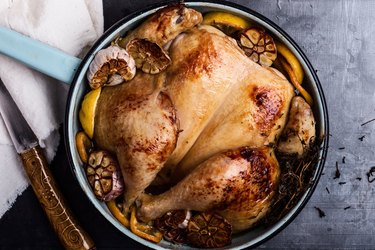
Roasting a whole chicken in a bag is an economical and simple way to prepare this classic Sunday-supper treat. Pan-roasting any meat usually results in a greasy pan with caked-on food that needs copious amounts of scrubbing.
Oven-roasting bags made from heat-resistant nylon not only mean minimal post-meal cleanup, but the bag traps the moisture during the cooking process, ensuring that your chicken comes out flavorful and juicy.
Video of the Day
Video of the Day
Note that cooking in a brown paper bag is not a suitable replacement for an oven bag. According to Michigan State University, paper bags are not sanitary, and can lead to a fire.
Read more: How to Bake a Plain Chicken Breast
Step 1: Heat the Oven
Heat the oven to 350 degrees Fahrenheit.
Step 2: Prep the Chicken
Remove any giblets or other surprises from the chicken's cavities. Rinse the chicken thoroughly, inside and out, under cold, running water, and pat it dry with paper towels.
Brush the outside of the chicken with melted butter or olive oil, and season it to taste with salt and pepper.
Step 3: Coat the Bag
Open the oven-roasting bag and add 1 tablespoon of all-purpose flour. Close the bag and shake it to coat the inside of the bag with the flour.
The flour will blend with the juices to create gravy and will also prevent the bag from bursting during the cooking process.
Step 4: Place Chicken in Bag
Place the chicken in the bag and then into a roasting pan. Close the bag securely with the ties that came with the bag or with kitchen twine.
Cut six 1/2-inch slits in the top of the bag so that steam can escape and tuck any loose ends of the bag into the roasting pan.
Step 5: Cook Your Chicken
Cook the chicken for 1 to 1 1/4 hours for a 3 1/2- to 4-pound chicken or 1 1/4 to 1 1/2 hours for a 5- to 7-pound chicken.
Step 6: Remove and Rest
Remove the roasting pan from the oven. Cut the bag from the top rather than the sides so that the juices do not run out and lift the chicken out of the bag.
Place it onto a cutting board or serving platter and allow it to rest for 10 to 15 minutes. Stir the juices in the bag until they are smooth and pour into a small bowl or gravy boat.
Step 7: Slice and Serve
Slice the chicken into thin slices and serve with the residual juices.
Read more: General Nutritional Facts About Chicken
Oven Bag Recipes
To give your bird additional flavor, season it with some fresh or dried herbs before roasting. Chicken goes particularly well with rosemary, thyme and sage, although there are many herbs you can use.
You can also place herb sprigs inside the chicken, or give it a citrus flair by stuffing it with halved lemons or oranges.
Make it a one-dish meal by adding some cut-up vegetables to the bag before roasting. Stuff your roasted chicken with an orange and onion half, as well as half a head of garlic and sprigs or oregano, thyme and parsley. Or try cooking your chicken on a bed of onion, carrots and fennel.
Practice Food Safety
To help reduce your risk of food poisoning, keep your fresh chicken refrigerated at 40 degrees Fahrenheit or lower and cook it within one to two days, advises the USDA Food Safety and Inspection Service.
Raw and undercooked chicken is associated with bacteria such as salmonella, staphylococcus, campylobactor and listeria. The Academy of Nutrition and Dietetics cautions that you should never serve chicken with an internal temperature below 165 degrees Fahrenheit.
Use an instant-read thermometer inserted into the thickest part of the chicken's thigh to determine if it is properly cooked. If you have also stuffed the chicken, make sure that it also reads 165 degrees on the thermometer.
Things You'll Need
Whole chicken roaster
2 tablespoons melted butter or olive oil
Kosher salt
Coarsely ground black pepper
1 tablespoon flour
1 large oven-roasting bag
Roasting pan
Scissors or sharp knife